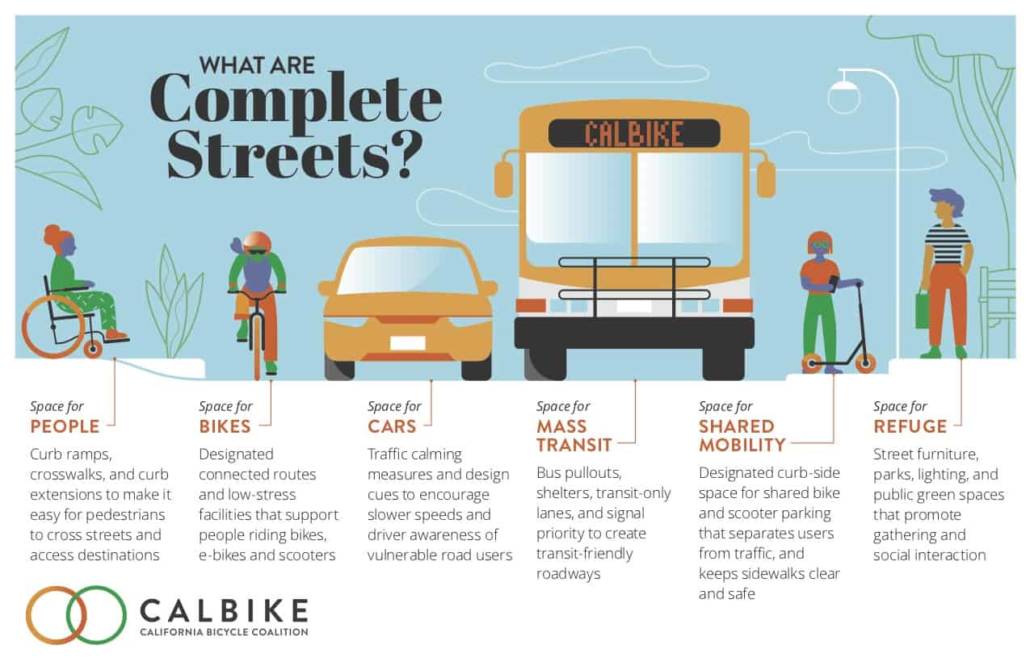Talking Back to Bikelash
At CalBike, we hear it all: Bike riders get in the way of car drivers. We should get off the road. Why are we promoting dangerous behavior, like the Safety Stop?
If only those crazy bicyclists wouldn’t…
We’re sure you hear variations of this, too, ranging from rude (uninformed comments from acquaintances) to downright scary (threats hurled from the window of a two-ton vehicle). As more people are using bikes for fun and transportation since the pandemic, particularly with the rise in popularity of e-bikes, bikelash (a backlash against the popularity of bike riding) has gotten noisier.
We’ve been thinking about how to respond to some of the more common comments from people who are hostile to biking or simply misguided. Here are a few suggestions for talking back to bikelash.
General principles: Bike riders and car drivers are not enemies
A while back, The War on Cars podcast had sex advice columnist Dan Savage on as a guest. In drawing parallels between the campaign for marriage equality and the movement for safe streets, Savage highlighted the importance of straight allies in winning gay marriage.
“Drivers are cyclists sometimes, and almost all cyclists are passengers sometimes. And we need to blur those lines just like we blurred the lines between queer people and straight people by convincing them that, like, we’re right there. We’re in your workplace, in your family, in your community, on your block, and maybe getting on with us is gonna be better, not just for us, but for you, too.”
Dan Savage on The War on Cars Podcast, November 15, 2022
Protected bike lanes have been shown to reduce fatalities for people in all modes of transportation, including people in cars. Everyone is a pedestrian for at least some space of time during the day, even if it’s just walking from their car to the door. We all want safe streets where we don’t have to live in fear that our children or grandparents might be struck by a car without warning.
It’s easy to be angry at people in cars, especially if a careless or spiteful driver has menaced you (something that has happened to many of us at one time or another). But bike riders are in the minority, and our success in winning acceptance and support for the infrastructure we need to make biking safe relies on support from people who aren’t bike riders (yet).
That sets the stage as we consider how to respond to people who complain about bike riders, on and off the road.
Responses to bike naysayers
Here are some of the more common negative things we hear about people on bikes and some responses to pivot to a more productive conversation (or at least respond constructively).
Bikes should get off the road.
People driving cars get stuck behind lots of things, most commonly other cars in traffic jams, road construction, etc. However, driving behind a slower-moving bike seems to generate an extra level of frustration in some drivers.
How to respond:
- To a driver who honks and yells, wave and smile!
- Don’t engage in a situation on the street that’s getting heated. You don’t want to be dead right.
- When discussing with a friend after the fact, ask them to look at their clock when they get stuck behind a bike and look again when they are able to drive faster. The short duration of the slowdown may help put it in perspective.
The War on Cars had a discussion on whether to confront drivers that offers more perspectives on this topic.
Bikes should get off the sidewalk.
Bike riding on the sidewalk isn’t ideal, but on busy roadways with no bike lane, the sidewalk may be the only safe space where a bike can pass. Sidewalk riding can close gaps in bike networks and allow people to get to destinations that aren’t adjacent to bike facilities, like protected lanes or off-road trails free from traffic.
How to respond:
- A common walking speed is about 3 mph. Bike riders commonly travel at around 10 mph. If the Sidewalk Riding Bill (AB 825), which CalBike supports, passes, bikes will be limited to no more than 10 mph on sidewalks and required to defer to pedestrians. The danger to pedestrians from bikes on sidewalks is much smaller than the danger to bike riders from potential collisions with speeding cars.
- We need more protected bike lanes and bike paths and lower speed limits. Then there would be little or no need for bikes to share the sidewalk. Until then, sidewalk riding is essential to bike safety.
- There may be a few people who ride unsafely on the sidewalk, which is understandably scary. Sidewalks are safe spaces from car traffic. Imagine having to walk along the edge of a street full of speeding motorists without the protection of a curb — that’s what we ask bike riders to do when we don’t allow sidewalk riding in areas without bike facilities.
Bikes are a menace on shared-use paths.
There will always be a minority of rude or careless people using any mode of transportation. Most of us have seen car drivers blow through red lights or stop signs, fail to stop for pedestrians in crosswalks, menace other drivers or vulnerable road users with their vehicles, and so on. That doesn’t excuse bike riders who ride too fast or too close to walkers on shared paths, but we suspect that happens way less frequently than close encounters with cars.
How to respond:
- Let the person know that you always ride carefully around pedestrians and that you don’t hold them personally responsible for poor path-sharing etiquette you witnessed from someone else.
- If paths are too crowded, that community probably needs more recreational paths, including bike-only paths where people who want to ride faster can have the space to do so. In the meantime, we should all watch out for each other.
Conventional bikes are okay, but e-bikes are a menace.
As e-bikes have become more popular, an e-bike panic has begun to circulate. Much of the anti-bike rhetoric from past years now focuses on e-bikes (while non-electric bikes are suddenly just fine). This has led to measures that will deter new riders and a broader adoption of bicycling, such as a recently introduced bill (AB 530) that would require e-bike riders to get licenses.
How to respond:
- E-bikes are bikes. Repeat: e-bikes are bikes. They aren’t scooters or mopeds or motorcycles. They handle pretty much just like any other bicycle but with an electric assist to supplement the rider’s energy with battery power.
- Most e-bikes (Class 1 and 2) don’t engage faster than 20 mph. Road bikes can easily go that fast without motors, and most e-bike riders don’t operate their bikes at top speed all the time. So e-bikes aren’t significantly faster than classic bikes.
- The average e-bike is heavier than a standard bike. Because of this, most e-bikes have beefy brakes so they can stop quickly. But an e-bike is much lighter than a moped or motorcycle. E-bikes are still bikes.
- Bicycle safety classes are terrific. We hope they will become more available and more riders of all kinds of bikes will take them. But no safety class or e-bike license can save a bike rider’s life if they’re hit by a speeding or careless car or truck driver. The best thing to protect people on bikes from being hit is better infrastructure, such as protected bike lanes, protected intersections, and traffic calming measures to prevent speeding. Infrastructure changes take time, but they can happen much more quickly than they currently do in California. If we made a commitment and allocated the funding to back that commitment, we could have roads that reduced deaths for all users in less than a decade. Let’s work toward that future!
Bike riders are at fault in at least half of bike/car collisions.
Accident statistics from police investigations of collisions between bikes and cars reinforce the trope of “those crazy bicyclists!”
How to respond:
- People in cars often say, “The bike came out of nowhere” when they hit someone. That doesn’t necessarily mean the bike rider was irresponsible; it might mean the driver of a vehicle that weighs thousands of pounds wasn’t turning their head, scanning the roadway, or accounting for their blind spots.
- Police have a “windshield perspective” because most patrol officers spend their days behind the wheel of a car. Bias toward motor vehicles and a lack of awareness of what constitutes safe cycling can skew collision reports. The determination of fault in car/bike crashes is unreliable at best and biased at worst.
- We need better driver education to share the road safely with people walking and biking.
Nobody bikes anyway. Why should we build bike lanes?
A common pushback to building bike infrastructure is that bike lanes serve too few people, so bikes don’t deserve to have precious road space allocated to them.
How to respond:
- Just as motor vehicles rarely drive on roads that aren’t built yet, people can’t ride in bike lanes that don’t exist. In cities like Amsterdam and Copenhagen, more than 50% of trips are made by bike because those cities have made biking convenient and safe.
- Bike lanes make all road users safer. Studies have shown that, on streets with protected bike lanes, fatalities go down for people biking, walking, and traveling by car. A bike lane could save your life!
- Nobody will be forced to stop driving, but creating infrastructure that makes it safer and more convenient to bike, walk, and take transit gives people more options, allowing those who don’t want to or can’t drive to get around more easily. That means more space on the streets for those who need or choose to drive.
People don’t want to ride bikes.
When bike advocates offer biking as one part of the solution to climate change, some people scoff at the idea that enough people would want to get around by bike to make a difference.
How to respond:
- Many people enjoy swimming, but they probably wouldn’t be enthusiastic about swimming in shark-infested waters. Our unsafe streets are a deterrent to trying biking. There are many people who fall into the “interested but concerned” category: They don’t ride now because of safety but would try it if they felt they could ride without risk.
- When was the last time you were on a bike? It’s fun! Come on a ride with me!
For more on how to respond to bike naysayers, see Momentum Magazine’s bikelash tips.
How do you talk back to people who don’t see the value of biking? Share your tips with us on Twitter, Facebook, or Instagram.



